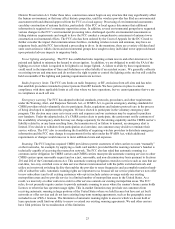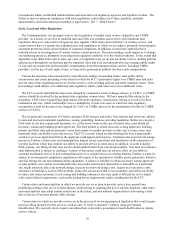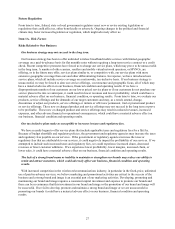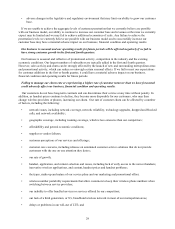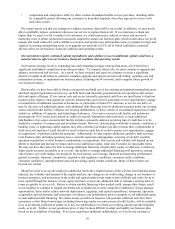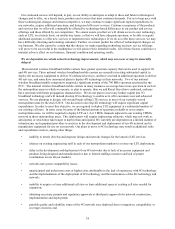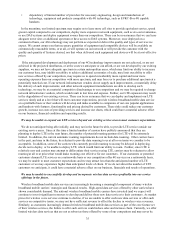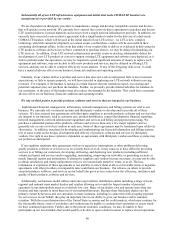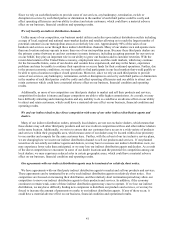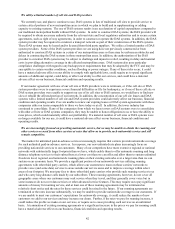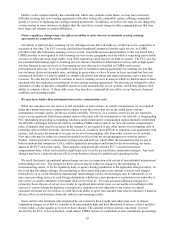Metro PCS 2009 Annual Report Download - page 45
Download and view the complete annual report
Please find page 45 of the 2009 Metro PCS annual report below. You can navigate through the pages in the report by either clicking on the pages listed below, or by using the keyword search tool below to find specific information within the annual report.33
We may not be able to respond quickly or effectively to new marketing and sales initiatives launched by our
competitors.
Many of our competitors have far greater resources, including sales and marketing resources with far larger
marketing budgets than we do. We do not know and cannot anticipate what sales and marketing initiatives our
competitors may launch or the magnitude of their efforts. As a result, our response may be ineffective after our
competitors have already launched their sales and marketing initiatives and may be delayed by longer lead-time
elements in our business system, such as network resources and billing software. Further, our business model is
premised on the company achieving and maintaining a low cost structure, which we achieve by centralizing certain
sales and marketing activities and designing and implementing major sales and marketing efforts across all of the
metropolitan areas we serve.
Further, in general, we also do not spend as much on advertising and marketing as some of our competitors. We
generally have had, and anticipate in the future having, less sales and marketing resources than our competitors, and
we have spent, and anticipate spending, less on advertising and marketing than our competitors. We generally do
not have the resources to respond to all advertising and marketing initiatives of our competitors and consequently
our efforts may not be effective. As a result, our response may be inadequate to competitive initiatives, which may
allow our competitors to gain competitive share and to have an effect on our brand and sales and marketing efforts.
We may not have time to conduct extensive customer focus groups or sales trials before launching our sales and
marketing initiatives companywide. As a result, our initial sales and marketing initiatives may not adequately
respond to our competitors’ sales and marketing initiatives. If we are unable to respond quickly enough or
effectively to new marketing and sales initiatives launched by our competitors, it could have a material adverse
effect on our business, financial condition, and operating results.
We may not have a large enough supply of handsets to meet the demands of our customers.
Our marketing and purchasing personnel are required to coordinate their activities to ensure that our distribution
channels have adequate sales stock to support our sales and marketing initiatives. If we fail to maintain an adequate
sales stock to support our sales and marketing initiatives, we could have excessive customer demand for handsets
with only a limited supply or an excess supply of handsets for which we have no demand. Additionally, we may fail
to predict and select the appropriate handsets for our marketing and sales initiatives resulting in us not meeting our
customer’s demands.
The wireless industry is experiencing rapid technological change.
The wireless telecommunications industry has been, and we believe will continue to be, characterized by
significant technological change, including the rapid development and introduction of new technologies, products,
and services, such as voice-over Internet protocol, or VoIP, push-to-talk services, location-based services, such as
global positioning satellite, or GPS, mapping technology, social networking services, and high speed data services,
including streaming audio, streaming video, mobile gaming, music and file downloads, advertisement paid services,
video conferencing and other applications. These technological advances, evolving industry standards, ongoing
improvements in the capacity and the quality of digital technology, such as the implementation and development of
3G technology, wideband technologies such as WiFi or WiMax which do not rely on FCC-licensed spectrum, or the
development of 4G technology, such as LTE, and the development of data and broadband capabilities, could cause
the technology used by us on our wireless broadband mobile network to become less competitive or obsolete.
Additionally, VoIP is an emerging technological trend that could result in a decrease in demand for switched
telephone services, such as those we currently provide. The resulting technological development of WiFi or WiMax
enabled handsets permitting customers to communicate using voice and data services with their handset using this
VoIP technology in any area equipped with a wireless Internet connection, or hot spots, could potentially allow more
carriers to offer larger bundles of minutes while retaining low prices and the ability to offer attractive roaming rates.
The number of hot spots in the U.S. is growing rapidly, with some major cities and urban areas approaching
universal coverage. Further, the development of new equipment, such as femtocells, could allow our competitors to
offer increased usage without increased cost thus reducing our cost advantage. As a result, competitors using more
traditional and commercially proven technological advances to provide service or using more efficient, less
expensive technologies (including those not yet developed), may have a competitive advantage over us by retaining
and increasing their customer base and realizing certain economies of scale. As the CDMA infrastructure of our
network becomes less popular or obsolete, the cost of compatible equipment and technology may also increase and
we may also be subject to significant write-offs or changes in estimated useful life.


